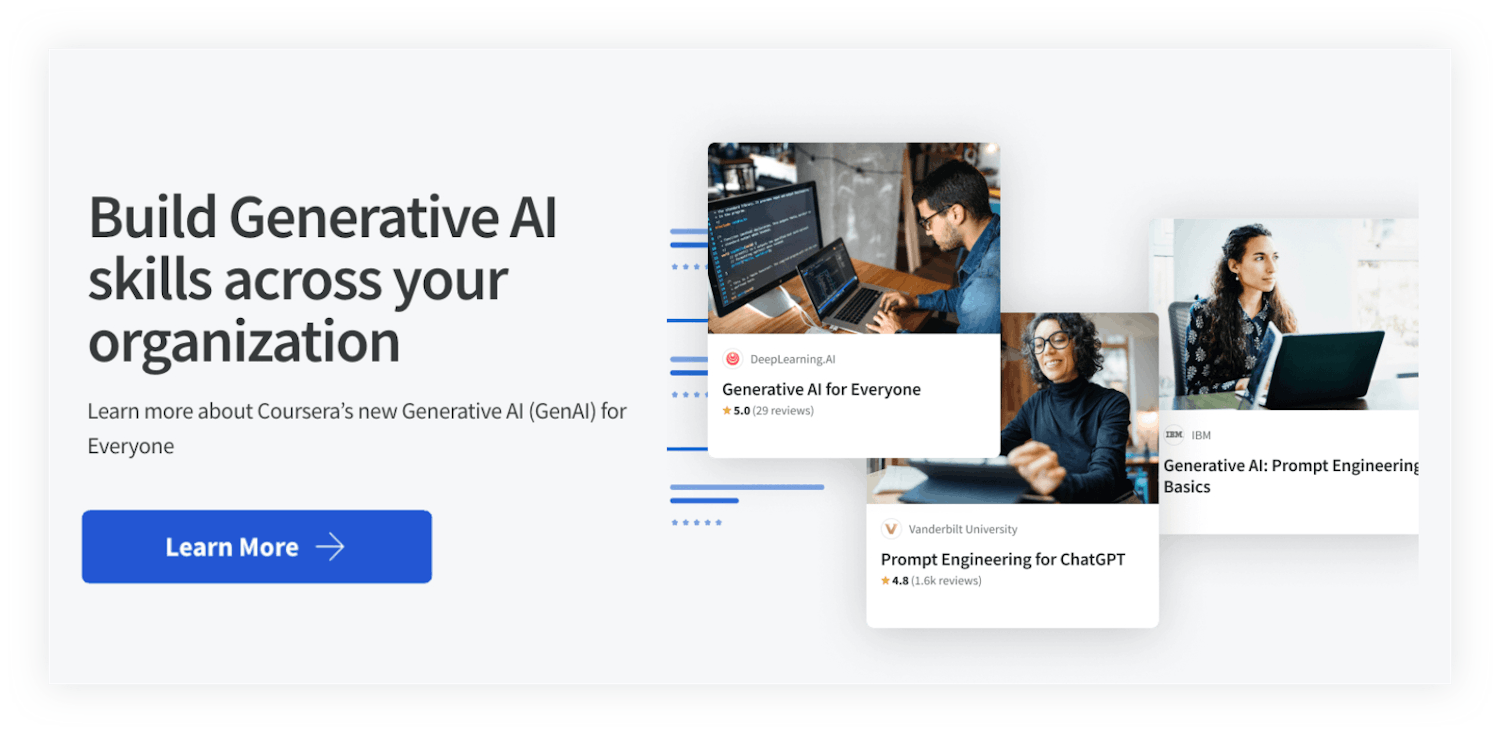AI in Education: Approaches and Strategies for Educators
Discover how AI can enhance learning, the pros and cons of using AI in education, and ways you can implement AI into your classroom.
![[Featured Image] A college professors discusses the future of AI in education with his classroom.](https://d3njjcbhbojbot.cloudfront.net/api/utilities/v1/imageproxy/https://images.ctfassets.net/wp1lcwdav1p1/40xNWmYIoFkfE4EvyYeSn0/8d5f203b481f9b9929ce999d3c239246/GettyImages-464675323.jpg?w=1500&h=680&q=60&fit=fill&f=faces&fm=jpg&fl=progressive&auto=format%2Ccompress&dpr=1&w=1000)
As artificial intelligence (AI) and generative AI (GenAI) become more advanced, they’re becoming increasingly visible across all business sectors—and education is no exception. These tools and technologies can be used to automate administrative tasks, draft lesson plans, and improve learning outcomes. At the same time, there are some risks to be aware of as you begin incorporating AI into your teaching and learning workflows.
Explore suggestions on approaching AI in education, some beneficial use cases, and potential challenges. Then, discover how you might use AI in your education programs with a look at some AI tools and how to prompt them as you develop your strategies.
What is AI?
Before we discuss AI in education, it’s important to have a baseline understanding of AI and GenAI.
AI is the development of computer systems capable of performing tasks that historically required human intelligence, such as recognizing speech, making decisions, and identifying patterns. This umbrella term encompasses several technologies, such as machine learning (which uses algorithms) and deep learning (which uses a system of neural networks modeled after the human brain).
As you incorporate AI into your teaching processes, you’ll likely use GenAI. GenAI allows users to input prompts to generate new content, such as text, images, code, and other media.
GenAI tools tend to use natural language processing (NLP), meaning they can interpret and react to standard human language, which makes them user-friendly. ChatGPT and DALL-E are two examples of popular GenAI tools. Thanks to NLP, you don’t need to know all of the inner workings of AI to benefit from AI tools.
Learn more: Deep Learning vs. Machine Learning: A Beginner’s Guide

How to approach AI in education
AI and GenAI tools are developing and evolving technologies; treating them as such is good. As you move toward incorporating AI into your workflow, remember that these tools are meant to supplement and augment your current processes—not replace them.
Here are four recommendations for approaching AI in an educational setting:
The relationship between educators and students is important for success, and current technologies can’t replicate them. Remember to check your AI tool’s work, incorporate your expertise, and personalize your processes.
Develop a cohesive approach to AI throughout the educational system. When boards, administrators, and teachers align on an AI strategy, you can better prepare to benefit from AI’s potential while safeguarding your students and school system from the potential pitfalls of AI.
Continue to incorporate modern teaching and learning principles into your educational practices. AI learns from the data it receives and may not always be equipped with the most current information. It remains important to consider the research you do and the perspective you bring as an experienced educator.
Stay up-to-date on the latest AI developments. When you’re working with a rapidly developing technology, it’s important to remain aware of the changes that may be happening with each application update or new tool release. Pay attention to the latest AI and GenAI news to ensure you use your tools effectively.
Benefits of using AI in education
In the same way that AI has benefited other areas of society, using AI in education can also have several positives. Here are some beneficial ways to use AI in education:
Automate or semi-automate administrative tasks: You can use AI to assist with some of your more routine administrative tasks, such as creating schedules, designating groups of students for projects, or simple grading procedures. You can also use AI tools to draft lesson plans, worksheets, and emails.
Assist with research and brainstorming tasks: You can use AI as a thought partner during the research process or when brainstorming new ideas. For example, you can ask ChatGPT to generate several variations of essay questions on a designated topic. Similarly, students can ask ChatGPT to clarify their questions on a specific research topic or generate ideas for further investigation.
Personalize learning experiences: You can use AI to track student progress and identify areas where they may need additional support. You can then create learning plans and assignments tailored to students’ individual needs.
Potential challenges of AI
Alongside the benefits of AI come some challenges and risks. Here are some of the potential areas of concern worth being aware of before you start using AI in your classrooms:
Ethical concerns and bias: Regardless of the type of AI, all AI starts with human-fed data and design. This means that AI can potentially inherit some of the same biases humans experience. It’s important to research the AI ethics that guide the tools you plan to use and to be aware of the potential for bias as you review any AI output you plan to incorporate into your teaching and learning plans.
Privacy concerns: Some types of AI store and analyze inputs, often to tailor future outputs. For this reason, take caution when inputting sensitive or personal information pertaining to both educators and students. As with all new technologies, before you begin using any AI tool in your educational workflow, be sure to review the company’s data and privacy policies to learn what information they may be storing, how it’s used, and whether you can opt out of data storage.
Cheating or dependence concerns: Countering AI's productive learning benefits, it’s possible to rely too heavily on AI tools. AI can hinder learning if it’s used in place of critical thinking skills. As an educator, it’s worth considering how you can continue encouraging critical thinking growth, knowing that students can access GenAI tools while writing essays and completing homework assignments.
How to use AI in education
Developing your AI strategy will include selecting tools that fit your education system and use cases that educators deem appropriate for AI incorporation.
Here are some popular GenAI text tools:
ChatGPT: OpenAI’s application which was the first tool of its kind to receive wide public attention upon its launch.
Bard: Google’s application which is comparable to ChatGPT, but users tend to describe a more user-friendly interface and more casual tone than OpenAI’s app.
Bing Chat: Microsoft’s application acts similarly to its Bing search engine but is enhanced by OpenAI’s generative technology.
Claude: Anthropic’s application, which is capable of producing high word-count inputs and outputs.
New GenAI tools are being developed, released, and updated frequently. To decide which of these text-generation tools is suitable for your educators, test the user experience and output of each, and consider the privacy and ethical considerations guiding each tool’s development.
AI prompting for educators.
To use the above text-generation tools, you’ll need to write prompts that guide the application toward your desired output. There are six pieces of information that can be worth including in your prompt:
The tool’s role
Your project description
Project context
Output specifications
Rules and constraints
Output examples
For example, you may prompt:
You are a writing teacher speaking to a student with a fourth-grade reading level. You want to teach a lesson about metaphors and symbolism. Create a lesson plan with definitions of both concepts, bullet points comparing and contrasting metaphors and symbolism, and an example of each. Then, write three questions to ask the student that will demonstrate their comprehension of both concepts.
Using AI at your school
Upskill your educational workforce with Generative AI Academy on Coursera. Access top-ranked courses from industry and academic leaders like DeepLearning.AI, Google, IBM, and Vanderbilt University.

Coursera Staff
Editorial Team
Coursera’s editorial team is comprised of highly experienced professional editors, writers, and fact...
This content has been made available for informational purposes only. Learners are advised to conduct additional research to ensure that courses and other credentials pursued meet their personal, professional, and financial goals.